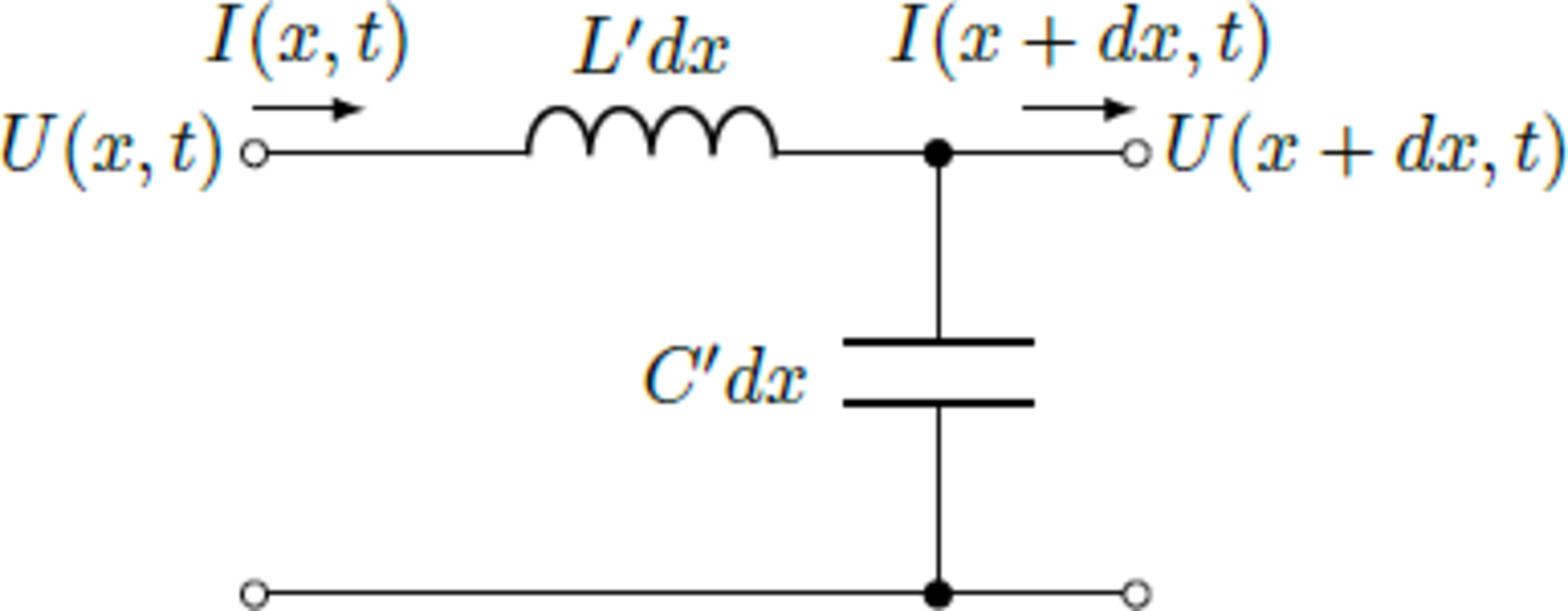Signal transport inside a coaxial cable

A coxial cable consists of an inner conductor and an outer conductor, which are insulated from each other by a dielectric. While the outer conductor acts as a shield and is earthed, an AC signal is transmitted through the inner conductor. The coax acts both as a capacitor and as an inductance, so that electrical signals propagate only with a certain delay in the cable. In this task we assume for the capacitance and inductance the values C ′ L ′ = l C = 3 ⋅ 1 0 − 1 1 m F = l L = 1 . 5 ⋅ 1 0 − 6 m H per meter. What is the speed of electromagnetic waves in the cable in units of vacuum light speed c 0 ≈ 3 ⋅ 1 0 8 m / s ?

Hint: A cable part of the length dx has a serial inductance L = L ′ d x and a parallel capacitance C = C ′ d x and can be described by the equivalent circuit shown on the right. Use the formulas U C U L = C Q = L d t d I for the voltage drop along the capacitance and the inductance and derive differential equations for the current I ( x , t ) and the voltage U ( x , t ) . Show that they satisfy the wave equation ∂ t 2 ∂ 2 I ∂ t 2 ∂ 2 U = c 2 1 ∂ x 2 ∂ 2 I = c 2 1 ∂ x 2 ∂ 2 U with the phase velocity c .
This section requires Javascript.
You are seeing this because something didn't load right. We suggest you, (a) try
refreshing the page, (b) enabling javascript if it is disabled on your browser and,
finally, (c)
loading the
non-javascript version of this page
. We're sorry about the hassle.
Here are the governing equations for the transmission line:
Δ U = − L ′ d x ∂ t ∂ I Δ I = − C ′ d x ∂ t ∂ U d x Δ U = − L ′ ∂ t ∂ I d x Δ I = − C ′ ∂ t ∂ U
Taking the limit as d x goes to zero:
∂ x ∂ U = − L ′ ∂ t ∂ I ∂ x ∂ I = − C ′ ∂ t ∂ U
Take another spatial partial derivative of the voltage equation and another temporal partial derivative of the current equation:
∂ x 2 ∂ 2 U = − L ′ ∂ x ∂ t ∂ 2 I ∂ x ∂ t ∂ 2 I = − C ′ ∂ t 2 ∂ 2 U
Equating the mixed-derivative terms:
∂ x 2 ∂ 2 U = L ′ C ′ ∂ t 2 ∂ 2 U
By inspection, the general solution is of the following form (voltage expression is given, but current is the same):
U = f ( ± L ′ C ′ x + t )
This equation represents a traveling wave (either forward-propagating or backward-propagating). To determine the speed of propagation, consider a backward propagating wave:
U = f ( L ′ C ′ x + t )
Suppose we first look at the wave with space-time coordinates ( x 0 , t 0 )
U 0 = f ( L ′ C ′ x 0 + t 0 )
Suppose the time advances to t 0 + Δ t . Where does the same point on the wave reside spatially at this same time? To determine this, find the value of x which keeps the argument the same.
L ′ C ′ x 0 + t 0 = L ′ C ′ x 1 + t 0 + Δ t L ′ C ′ x 0 = L ′ C ′ x 1 + Δ t x 1 − x 0 = − L ′ C ′ Δ t
Thus, the wave propagates backwards. Determine the speed:
v = ∣ t 1 − t 0 ∣ ∣ x 1 − x 0 ∣ = Δ t L ′ C ′ Δ t = L ′ C ′ 1
Plugging in numbers, we see that this particular cable has a propagation speed equal to approximately half the speed of light.